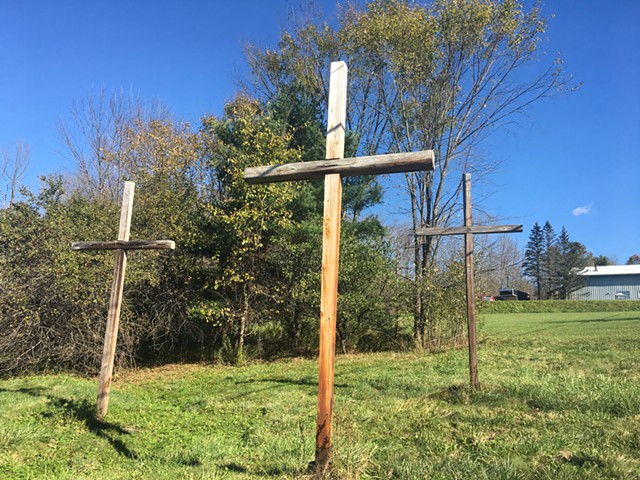
- Sadie Williams
- Crosses on the hillside in Randolph
Traveling along Route 66, many a Vermonter has noticed three large, freestanding crosses on a hillside in Randolph. They've been there a while: Bisbee's hardware store manager Ken Smith says he helped erect the structures about 20 years ago on the property of the then-newly built Green Mountain Gospel Chapel.
But are the crosses benign expressions of faith, or do they violate Vermont's billboard law, which outlaws advertisements on public roadways? One of our Randolph readers wrote to ask: WTF?
Passed in 1968, Vermont's landmark billboard law helps keep the state's scenic byways, well, scenic. Maine, Hawaii and Alaska are the only other states to have adopted similar legislation.
Statute 10 V.S.A. 495 aims to reduce visual clutter on Vermont's roadways, and it works. Travelers invariably note the difference when passing from Vermont into New Hampshire or New York.
While aesthetics played a part in the law, so did economics. Vermont's landscape is a major tourist attraction, so why cover it with advertisements?
Today, the only signs permitted on or visible from government highways are those erected by the state to direct safe traffic flow — with a few exceptions listed in 10 V.S.A. 494, such as signs for park-and-rides, fairgrounds and expositions, and hand-painted murals specifically related to downtown centers. In total, 17 circumstances can exempt a sign from the billboard law. The language of most of those exemptions refers specifically to signs, not to advertorial media, nor to crosses.
So, is a large, freestanding cross — or a set of three — a form of advertisement for the Christian religion or for the Green Mountain Gospel Chapel?
Chapel pastor David Dube says no. "I don't know about [them] as advertisements," he says in a phone interview. "They're just a symbol like any other cross on the church."
Except these crosses aren't on a church, but rather above the church and easily visible to passing motorists. Dube notes that, biblically speaking, the placement of three crosses in close proximity represents the crucifixion of Jesus at Calvary, where he and two thieves were sentenced to death.
Jared Carter, assistant professor at Vermont Law School, sees the crosses' purpose as "to advertise a religion, essentially," he says by phone. But he acknowledges the question is a complex one.
If the public crosses did qualify as advertisements, their legality would depend partly on their placement. Are the crosses on the highway right of way, or "on-premise," meaning on the property of the business in question?
The Green Mountain Gospel Chapel owns 5.5 acres in the crook of land between Hebard Hill Road and Route 66. While the crosses are close to the road, Dube says they are on church property. Tammy Ellis, senior manager for the Vermont Agency of Transportation, confirms in an email that "[an] area supervisor measured [...] the crosses, [and ...] it is highly likely that they are outside of the state right of way, which is generally 24'9" from centerline."
According to another state statute (10 V.S.A. 493), on-premise signs may be erected if they are "advertising activities conducted on the property," but they cannot exceed 150 square feet. Whether the cluster of crosses exceeds the limit depends on how one assesses their size.
Dube says he's not sure, but estimates the crosses measure about eight by four feet. Based on her own height, this reporter would put them at roughly 12 feet tall with arms four feet wide. They appear to be made of traditional 4-by-4 wooden beams, which (confoundingly) actually measure 3.5 by 3.5. The front-facing plane of one cross measures roughly five square feet, putting the combined planes of all three crosses at just under 15 square feet, well below the limit.
Measuring the rectangular area surrounding each cross gives a higher result, however. Three 4-by-12-foot rectangles comprise 144 square feet. If we add the space between the crosses, the actual three-cross area could approach or exceed the 150-square-foot limit.
If one holds that: a) a publicly visible Christian cross is an advertisement for the faith; b) the advertisement is on church property; and c) the on-premise advertisement exceeds 150 square feet, the crosses could be illegal.
Alternatively, one could argue that a publicly visible Christian cross is nothing more than a sculptural representation of a biblical story meant to reinforce the faith of existing practitioners, rendering further argument moot.
"There's arguments on all sides," Carter says, "and lots of questions." He suggests that passersby may not have drawn attention to the issue for fear of inciting a debate centered on freedom of religion and speech. "If it doesn't fit nicely into an exemption," he continues, the reluctance to challenge the crosses "could be the state feeling nervous about enforcing the rules against the church, because [they might be] impinging on the religious freedom of the church. But I'm just speculating.
"If I represented the church," Carter continues, "and the state tried to enforce that provision against me, I [might] very well argue that Vermont's billboard law violates my constitutional rights and that they're enforcing this against the church, which is protected under state and federal constitutions."
But, he reiterates, "It's a complicated issue," citing the Establishment Clause of the First Amendment of the U.S. Constitution, which holds that while the government can't discriminate against religious institutions, it also can't give them preferential treatment.
To John Dunleavy, assistant attorney general at VTrans, by contrast, the question looks pretty simple. "I don't think that it's an issue we would attempt to regulate under the billboard law," he says.
Unless our petitioner takes it to the Travel Information Council in the Agency of Commerce and Community Development, the body charged with enforcing the billboard law, the case of the three crosses will remain unsolved. In the meantime, enjoy the view.










Comments
Comments are closed.
From 2014-2020, Seven Days allowed readers to comment on all stories posted on our website. While we've appreciated the suggestions and insights, right now Seven Days is prioritizing our core mission — producing high-quality, responsible local journalism — over moderating online debates between readers.
To criticize, correct or praise our reporting, please send us a letter to the editor or send us a tip. We’ll check it out and report the results.
Online comments may return when we have better tech tools for managing them. Thanks for reading.